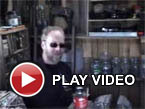Stephen Vitiello, "Listening to Donald Judd"
 Here is sound art created from recordings made in Marfa, Texas, on and around the Donald Judd installations in 2002. It is solidly in the camp of those who consider elements of weather and the environment to be musical, and silence to be something much rarer than gold.
Here is sound art created from recordings made in Marfa, Texas, on and around the Donald Judd installations in 2002. It is solidly in the camp of those who consider elements of weather and the environment to be musical, and silence to be something much rarer than gold.
This Sub Rosa release explores electronic hum and crackle and low level environmental buzz. Vitiello has to put in the hours to capture the raw material and then make decisions about which to process in the studio, and to what extent. His preferred method of tweaking is using older analog equipment which may account for the fact that this seems warmer and more organic than much installation music. Getting the most out of Listening to Donald Judd arguably relies on a familiarity with the art works in question. Without that, it probably comes across as an outtake from the Paris, Texas soundtrack.
Judd was an engineer in the military, studied philosophy and wrote art criticism. He declared that painting was "finished" and argued that objects should not represent anything, but merely exist. He refused the term minimalist when applied to his own work and had maximum talent for acquiring financial backing from the Dia Art Foundation to purchase much of Marfa. To put it simply, Judd's work revealed designers and engineers to be artists by exposing the architectural and industrial essence of buildings. He utilized the entire natural area as a huge gallery. It's not exactly Land Art in the strictest sense but somewhat similar in breadth. Judd impressively shed the shackles of gallery and frame. Though as a merging of art and nature, to be honest I prefer the naturalistic, transitory, beauty, created and filmed by Andy Goldsworthy. (Maybe someone will record one of Goldsworthy's ice sculptures or his amazing leaf or water based works.)
So, Marfa is now a somewhat unusual remote small town with ultra-modern galleries, a fancy restaurant, and the Chinati Foundation which showcases Judd and a few other artists, engineers, or whatever they choose to call themselves. Despite that, it obviously remains very quiet, and yet anyone, who finds everyday life to be ripe with portent, meaning, and the romance of ordinary mortality, will find these recordings attractive or maybe even moving. The droning quality of some sections is fitting since Judd's favorite instrument was bagpipes.
Vitiello has captured the sonic capacity of Judd's sculpture, an action that, amongst other things, again poses the question of where objects end, and examines their relationship to nature. The results are cleverly edited to make clear that this work is concerned, as Vitiello has made clear elsewhere, with space rather than time. I am reminded of a piece by Dallas artist Denise Brown; a memorial rendition of her father's hand sculpted from a block of wood and placed in her garden. Over time, the hand will absorb the environment as surely as it has changed the view of that corner of her garden. Vitiello inhabits an artistic terrain which would have us hear such an interaction. The hand may disintegrate completely (not all things are as durable as fired clay). I suppose that Judd would not have favored her representation, but surely there is an element of reproduction in even the most austere design. Where the back and forth transformation will end, I'm not sure. I like to think it won't.
Vitiello may be best known for both World Trade Center Recordings: Winds After Hurricane Floyd, derived from the placement, in 1999, of contact microphones on the 91st floor of Tower One, and also his co-production of a couple of From The Kitchen Archives releases. The six pieces here, crackle, drip, squeak, throb, and hum with life and its absence. This flow is punctuated by the relative excitement of a passing train. I recommend listening to them all fairly loud, but that may be sacrilege. The audio snippets I can provide offer scant insight into how the record deserves to be appreciated or despised in it's entirety.
Consider leafing through a copy of Judd's Complete Writings while hearing this document of a snapshot in space, rather than time.
Somebody once said that writing about music is like dancing about architecture. How many people would dance to Listening to Donald Judd is unclear, but I am reminded to finish refining a choreographed ode to the Norman doorway of Tutbury Church.
samples:



